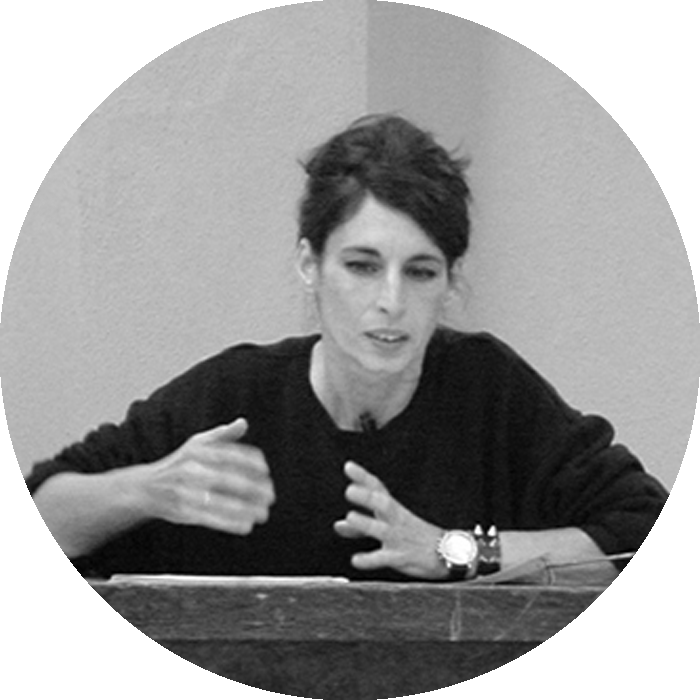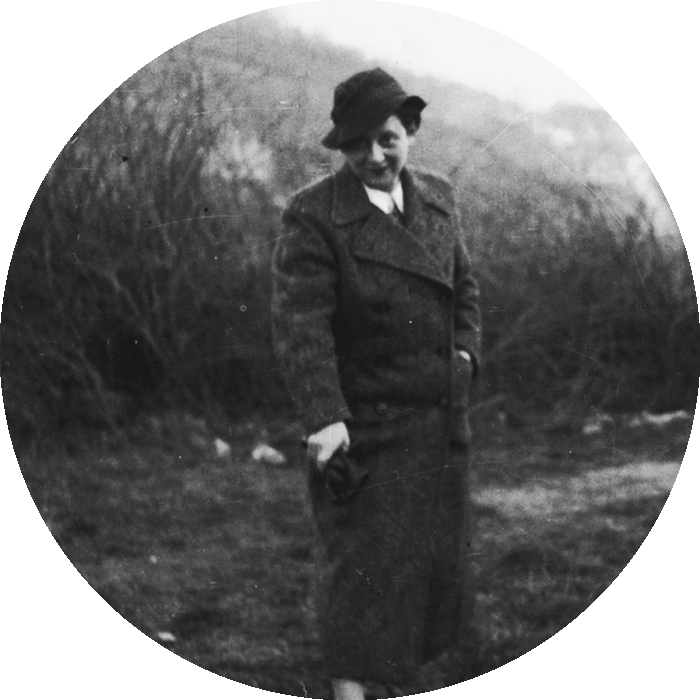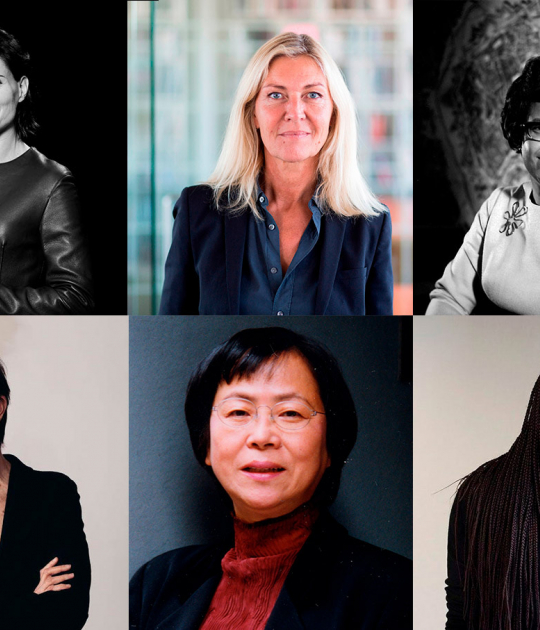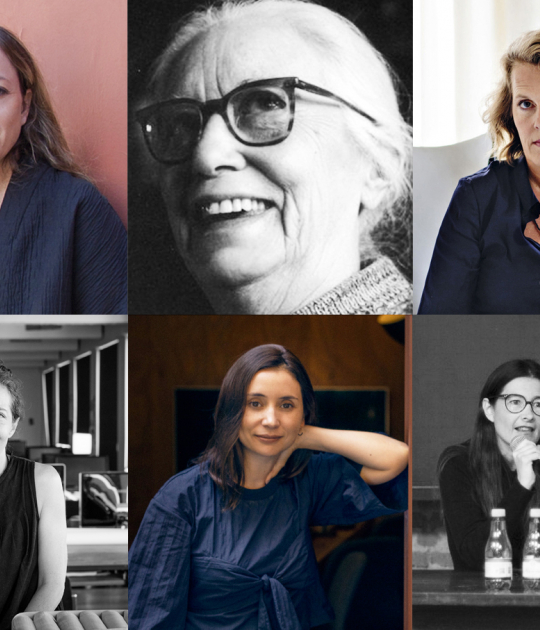These are the architects and studios selected this year.- Pauline Marchetti - Sensual City Studio, and Ferrier Marchetti. Atxu Amann - Temperaturas extremas. Friedl Dicker-Brandeis. Wera Meyer-Waldeck. Ana Luisa Soares - fala. Marion L. Mahony Griffin. Renée Gailhoustette. Rossana Hu - Neri&Hu. Minette de Silva. Olga Felip - Arquitecturia.
- Pauline Marchetti Sensual City Studio, Ferrier Marchetti

Pauline Marchetti is an architect, founding partner of the Ferrier Marchetti studio and professor at the École Nationale Supérieure des Arts Décoratifs in Paris. In 2019 she won the 40Under40 award, from the European Centre for Architecture Art Design and Urban Studies.
She develops a sensitive and humanistic approach to architecture and the city, which combines sustainable development and new technologies, in the search for innovation and urban delight. She proposes to design and research methods that are based on the sensory dimension of space: volume, materiality, light, and environment.
Her studio combines research and practice, exploring a new urban condition, finding and developing opportunities for cities to contribute to the ecological balance of the planet and create a positive relationship between climate and design. Her architecture is not just about designing objects, but about the opportunities that design offers to create positive and meaningful relationships between buildings and people, contributing to a more holistic, sustainable and sensual world.
In 2008 she began his collaboration with Jaques Ferrier, thus forming the Ferrier Marchetti studio, which in 2010 presented its Sensual City research laboratory, thus combining architecture, rehearsals and studies. Their work has been selected for several international exhibitions and they have given numerous conferences in prestigious places.
- Atxu Amann Temperaturas extremas

Atxu Amann practices architecture from the Temperaturas Extremas studio and teaches in the Department of Architectural Graphic Ideation of the Madrid School of Architecture. In both facets she has received recognition for the innovative nature of her work.
She herself declared that all her activities throughout her life trajectory of continuous learning, training and strangeness, are linked to actions of ideologically positioned social content and aimed at the fight for a more dignified and just world in general, and in thecase of women and historically disadvantaged groups in particular.
Since 2006 she has been a Doctor of Architecture with the thesis "Domestic space: Women and the house", where, according to her own words, she tries to establish the links between ways of thinking, seeing the world, ways of life and housing, and in particular, to warn of the fundamental changes that the last century has brought about in the Western world: the information revolution, and above all, the women revolution.
In the housing projects of the studio that she founded together with Andrés Cánovas and Nicolás Maruri, conventional residential types are questioned to offer users the possibility of appropriating a space according to their real needs, seeking social sustainability. At the same time, she pays special attention to the spaces in between, filter spaces between the interior and the exterior and to the relationship among the neighbourhood.
In addition to residential buildings, many of them built after winning public competitions, they are also authors of well-known projects for cultural facilities in which they reject known solutions and opt for architecture as an instrument of thought and action from the project, even risk of attacking, modifying or transforming the works that precede them.
- Friedl Dicker-Brandeis

Friedl Dicker-Brandeis (1898 - 1944) was a well-known Jewish artist, architect, and educator, killed in World War II. She was one of the most prominent women at the Bauhaus for various reasons. She is an exemplary Bauhaus student with a wide range of artistic profiles, she was the prototype of a multidisciplinary artist, of which this article can only point out a small part.
Hes connection with the Bauhaus began when she began her studies at the private school of Johannes Itten, in 1916, one of the main figures in the founding of the school created by Walter Gropius. When the Weimar Bauhaus was inaugurated in 1919, Friedl Dicker followed Johannes Itten. She studied there until 1923. In 1921 the Teachers' Council decided that she Dicker would be one of the 12 students who would be exempt from paying academic fees during the semester.
She did textile design, bookbinding and participated in typography workshops. She designed costumes and sets for important plays such as William Shakespeare's "The Merchant of Venice." She also designed four variants of an architectural plan, together with Franz Singer (1896-1954), who also belonged to the group of Itten's Viennese pupils, characterized by unconventional developments. Her works related to architecture were carried out in the studio formed with Franz Singer under the unofficial name of Atelier Singer-Dicker. Among the collaborators of the study were Martha Hauska-Döberl, Anna Szábo or Leopoldine Schrom.
The convulsive situation in the 1930s complicated the professional and affective relationship of the Singer and Dicker-Brandeis couple. Dicker-Brandeis was associated with the Communist Party and she would be jailed for forging passports for her colleagues. Following her release from prison, Dicker-Brandeis would increase her commitment by designing propaganda posters for the Communist Party. Her black and white photo collages criticized the living conditions of the working class, warned of the imminent Nazi threat and condemned the consequences of the crisis of capitalism as ways that facilitated totalitarianism.
Friedl Dicker would be deported to the Theresienstadt concentration camp in 1942, where she continued to teach children drawing. In October 1944 she tried to reunite with her husband, volunteering to make the trip to Auschwitz where she was murdered. Several suitcases would be left behind from this tremendous period with almost 5,000 children's drawings and collages, a reflection of her generosity and also of her enormous brilliance.
- Wera Meyer-Waldeck

Wera Meyer-Waldeck (1906 - 1964) was a German architect trained at the Bauhaus in Dessau, in whose projects she raised themes that are still valid today. After studying to be a teacher and later at the Dresden Academy of Graphic Arts, she enrolled at the Bauhaus in 1927 to do carpentry and finally in 1932 she graduated in Architecture. Wera was a student who constantly had two very clear concepts in mind: work and the need to learn: "being interested in everything, understanding everything I study, without ceasing to be critical".
During the following period, Meyer-Waldeck did not have an easy time practicing as an architect, like most of her colleagues. During the years of World War II, she worked in different organizations and companies. Unfortunately, at the end of the war, women were expelled from high-ranking jobs so that men could occupy them. After the war she had several jobs in different cities in Germany until in 1950 she settled in Bonn. Her activity was always intense, she made numerous educational tours and gave lectures. Her concerns and her commitment to architecture did not cease in the following years.
Among Meyer-Waldeck's works, the "pilot homes” stand out. She defended that the relationship between the different spaces in each home varies according to the type of family that is going to live in it. One of the topics to be discussed will be the relationship between the kitchen and the living room, integrating them creating the same space for both uses, so that the people who cooked (women) were not isolated while they did so. Another issue that she dealt with would be the unwanted loneliness of the elderly in her home. To solve it, she proposed a new way of living.
This new way of living integrated different generations within the same group. Wera created a group of patio-dwellings, where four different dwellings lived together around a patio. Each house was built for a different type of family, whether it was a standard family with children or a single person.
- Ana Luisa Soares fala

Ana Luisa Soares is a Portuguese architect graduated from the Faculty of Architecture University of Porto and the University of Tokyo. She worked with Harry Gugger in Basel and Toyo Ito in Tokyo and is a visiting professor at the Bratislava faculty of architecture. Ana Luisa Soares is co-founder and partner of fala, a naive architecture studio based in Porto, together with Filipe Magalhães and Ahmed Belkhodja.
Fala focuses on the production of architecture on a residential scale and dreamlike competition proposals. The workshop optimistically works on a wide range of projects, from territories to bird houses. The projects are a mixture of formal languages, references, quotes and themes, without losing clarity; its architecture is intuitive but also eloquent. Her way of working is to start from a simple and innocent first idea and elaborate it so that it makes sense, giving rise to a coherent and complex result.
Since 2014, as part of fala, she has been giving lectures and classes all over the world. fala's work has also been widely published and has been exhibited at various events and institutions, such as the Portuguese Pavilion at the Venice Biennale, the Chicago Architecture Biennale, and in a solo show at Casa da Cerca in Lisbon. Among other recognitions, fala was awarded the "Spotlight" prize by Rice University and selected as one of the 50 most relevant young offices in the world by DOMUS magazine in 2020.
- Marion L. Mahony Griffin

Marion Mahony Griffin (1871-1961) was an American architect, the second woman to graduate as an architect from MIT in 1894. Throughout her career, which spanned three continents during more than six decades, she worked as a draftsman at the Frank Lloyd Wright's Oak Park studio and collaborated with Walter Burley Griffin, whom she later married.
In 1895 he began working in Frank Lloyd Wright's Oak Park studio, and for 14 years he was one of the most important people there. So much that when Wright went to Japan in 1909, he offered her to take charge of the studio. She declined the proposal but took charge of finishing the work that had been started. In January 1898, Mahony passed the Illinois State Architects' Licensing Examination; she was probably the first woman in the United States to obtain a professional license.
She became known for her exquisite architectural rendering, to such an extent that the signature image in the early Wright studio drawings is the one she created. Her drawings were inspired by the style of Japanese art prints, both in composition and technique and the buildings were surrounded by abundant nature.
In 1911 she won, along with her partner and husband, the competition for the new capital of Australia, Canberra. After the result was announced, only one journalist recognized Mahony's co-authorship and influence on the project. They continued to work in Australia and then, for financial reasons, they accepted a large project in India, until her husband died suddenly. After this she returned to Chicago, where she wrote an (unpublished) biography and continued to lecture, design and write.
- Renée Gailhoustet

Renée Gailhoustet. We could not forget in this article French architect Renée Gailhoustet (1929 -2023), awarded the Royal Academy Architecture Prize last summer, sadly passed away earlier this year.
Committed to communism, she focused on a little-recognized issue at the time: social housing. At the age of 24, she joined the studio of Marcel Lods, where she met Jean Renaudie, with whom she would live for fifteen years, have two daughters, and work together on many projects. Common guidelines are found in their respective works: a staggered organization of the dwellings, particular attention to the duplex organization, a desire to eradicate the corridors to project the dwelling around a central room, a large space left to the green space in the form of deep terraces.
Gailhoustet devoted her entire career to developing better social housing in the suburbs of Paris, she designed numerous housing blocks, including her best-known work: the 10-story Le Liégat complex in Ivry-sur-Seine, where she lived. and installed her studio. and the La Maladrerie semi-detached apartment block in Aubervilliers. Instead of large complexes, she planned various types of buildings, separated by open spaces, creating new horizons for the city and its social housing developments.
One of the instantly recognizable features of Gailhoustet's projects is the stepped, planted terraces that allow nature to permeate domestic spaces in ways rarely seen in high-density housing. Through the use of innovative geometries and the mix of uses in her buildings, Gailhoustet created a compelling argument for blurring the boundaries between interior and exterior, collective and individual.
- Rossana Hu Neri&Hu

Rossana Hu is a founding partner of Neri&Hu Design and Research Office, an interdisciplinary international architectural design studio based in Shanghai. Founded in 2004, the studio handles projects ranging from master plans and architecture to interior design and graphic design. Based on research, Neri&Hu bases its style on the dynamic interplay of experience, detail, material, form and light rather than sticking to a ready-made one.
Through the practice of the profession, Hu has strengthened his view of architecture, which answers to a global worldview incorporating various overlapping design disciplines, while also strongly believing in research as a design tool, as each project has its unique set of contextual problems.
Alongside her design practice, Hu has been deeply committed to architectural education and has lectured across the globe at various universities and professional forums. Having recently finished teaching as a Design Critic in Architecture at the Harvard Graduate School of Design following her last appointment in 2019, Hu began teaching as Eero Saarinen Visiting Professor at Yale School of Architecture in 2022 spring, where she received the distinguished Norman R. Foster Visiting Professor Chair in 2018. Rossana was appointed as Chair of the Department of Architecture at Tongji University in 2021.
Hu is also Founding Partner of Design Republic in Shanghai since 2004, a design platform incorporating retail concepts, design and cultural exhibitions, and education. In 2015, she was appointed as the Creative Director of Stellar Works and has served on the International Advisory Board of the Shanghai Symphony Orchestra since 2018.
- Minnette de Silva

Minnette de Silva (1918 - 1998) was Sri Lanka's first female architect. A pioneer of Modern architecture in her country, she belonged to the young generation that participated in CIAM 6 in Bridgwater in 1947 and was the first Asian woman to be a member of the RIBA. However, the work and legacy of one of the most famous architects of her day have been forgotten, and both her studio and her house, as well as many of the buildings she built, are in a precarious state or ruined.
At CIAM she presented work by MARG, India's research group on modern architecture, whose objective was the exposure and discussion of the modern avant-garde seen in all fields as the appropriate language for a post-colonial society. They sought the synthesis of the modern with the colonial, understanding that modernity in the tropics could not be the same as in the West.
Her first work was the Karaunaratne house, an experiment in regional modern architecture. The split-level house combined modern construction and materials such as reinforced concrete and glass bricks with local craftsmanship and materials. Minnette De Silva would call this architecture trans-regionalist since she added movable panels of traditional Japanese architecture to the open plan to make the internal partitions, and it was surrounded by a gallery typical of local architecture, adapting the building to the climate and the social conditions, and blurring the line between the house and the garden.
From there, she began designing and building all types of buildings, from cabins to villas and entire apartment blocks. Her hallmark was to develop modern architecture in harmony with the landscape and traditional crafts.
From the early 1980s, when she retired from it, until the end of her life he worked on her memoirs, which were published shortly after her death Life and Work of an Asian Woman Architect ( 1998). The book is a collage of experiences in which she reveals the difficulties or prejudices that she had to face: "exoticized" in London, Le Corbusier saw her as the personification of the romantic vision of India; for being a female architect in her country, within a very traditional and patriarchal society; for being a woman and not getting married, for being more aware of production than reproduction.
- Olga Felip Arquitecturia

Olga Felip Ordis (1980) is an architect born in Girona, Spain, and graduated from the Barcelona School of Architecture (2005), who during the last year of her degree did professional internships at the Carme Pinós studio. Felip is studying for a PhD at the Barcelona School of Architecture and is co-founder of the curatorial and design group MA!O and director of Architects for Architecture, an organization that promotes architecture as an instrument of progress.
Throughout her career she has received several awards, scholarships and recognitions, she was chosen Emerging Architect of the Year in 2013 and in 2015 she was awarded the Princess of Girona Arts and Letters Foundation Award, she has also obtained the Young Architect of the Year award 2010 for the LEAF Awards and 40under40 for The European Center of Architecture and The Chicago Athenaeum. In 2012 she was chosen to represent Catalonia at the Venice Architecture Biennale.
Her architecture is characterized by successfully combining the creation of new forms with respect for the environment, as well as by her sober, elegant, warm and bright work, which achieves a harmonious effect on the user, the viewer and the landscape.
In 2009 she founded, together with Josep Camps, the Arquitecturia studio, it is an office dedicated to architecture, design and urban planning. They have worked on cultural, educational, health and residential projects, both in the public and private sectors. In addition to their work as a studio, they are also dedicated to university teaching, and research through doctoral studies and participate in the promotion and dissemination of culture as directors of associations of architects.



























































